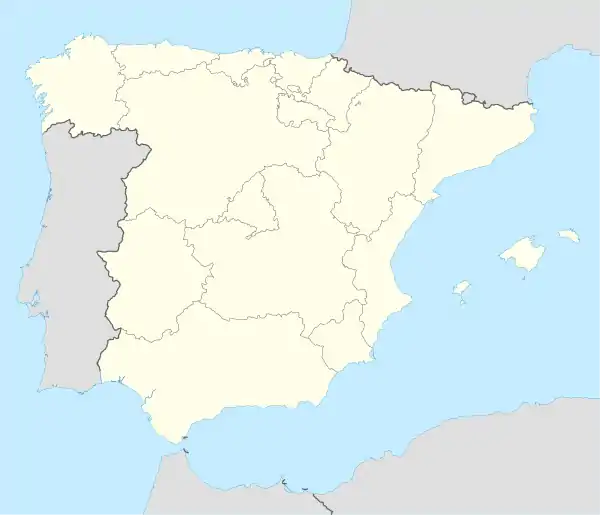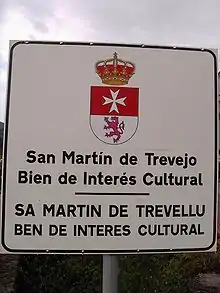Fala language
Fala ("Speech", also called Xalimego[2]) is a Western Romance language commonly classified in the Galician-Portuguese subgroup, with some traits from Leonese, spoken in Spain by about 10,500 people, of whom 5,500 live in a valley of the northwestern part of Extremadura near the border with Portugal. The speakers of Fala live in the towns of Valverde del Fresno (Valverdi du Fresnu), Eljas (As Ellas) and San Martín de Trevejo (Sa Martín de Trebellu).
| Fala | |
|---|---|
| Native to | Spain |
| Region | NW Extremadura |
Native speakers | (11,000 cited 1994)[1] |
| Language codes | |
| ISO 639-3 | fax |
| Glottolog | fala1241 |

Other names sometimes used for the language are Fala de Jálama or Fala de Xálima, but neither of them is used by the speakers themselves, who call their linguistic varieties lagarteiru (in Eljas), manhegu / mañegu (in San Martín de Trevejo) and valverdeiru (in Valverde del Fresno).
Even though it has no official status, and has little presence in schools and church, use of the language is vigorous, and the literacy rate in Fala is nearly 100%. As a linguistic community, speakers have a strong, independent identity; they have rejected implementing a standard orthography similar to or based on the Galician one. A translation of the New Testament has been published in Fala (2015).
History
Origins

In the Middle Ages, mixed varieties of Portuguese and Leonese could be found along the border between Leon and Portugal, represented in texts such as the Foro de Castelo Rodrigo (13th century). Although there is no documentation on the colonization and repopulation of this area in the 13th century, there are several hypotheses of Galician citizens moving to protect the frontier against Muslims as a punishment imposed by the Leonese king, or the delivery of the territories to various military orders by Kings Alfonso IX and Fernando II.
In general, philologists in favor of the Galician theory support the hypothesis that the valley is an isolated region and, therefore, the Galician colonists maintain their way of speaking in a "pure" form because of the lack of external influences.
This thesis is refuted if we contrast it with other historical data:
- It is considered that before the Galician-Leonese resettlement, this place was already occupied by Portuguese and even after the colonization there was contact with the neighboring country.
- From the 12th until the 16th century, both Portugal and León and Castile wanted the territory because of its importance as a border. It changed from one country to another so the population swore allegiance to one king or another.
- On the other hand, it is contradictory that the orders that these place was given, being enemies, resettled the region with people of the same origin.
Recent

On August 3, 1992, the association Fala i Cultura was founded, among its goals being the compilation of a common grammar (based on the Galician one) and the commemoration of u día da nosa fala (the day of our language) celebrated once a year from 1992 in Eljas, 1993 in Valverde and 1994 in San Martín.
It was not until 1998 that the first literary work in Fala was published: Seis sainetes valverdeiros, written by Isabel López Lajas and published in 1998 by Edicións Positivas (Santiago de Compostela). It was on this date that the Gabinete de Iniciativas Transfronterizas (Office of Cross-Border Initiatives) started to take interest in Fala and to promote its study, publishing in 1999 scientific works and celebrating in May a "Congress on A Fala".
On June 14, 2000, Fala was recognized by the Ministry of Culture of the Junta de Extremadura as Bien de Interés Cultural. Nowadays, although the inhabitants of Jalama Valley can speak Spanish, most of them are bilingual because at home and in other activities outside school, they continue using the local language.
Sociolinguistic surveys
In 1992,[3] a survey conducted by José Enrique Gargallo Gil (a professor at the University of Barcelona) collected the following data regarding the use of Spanish in family conversation:
- 4 of the 29 respondents from San Martín used Spanish when speaking with their family (13.8%)
- In Eljas the figure dropped to only 3 out of 54 respondents (5.6%)
- In Valverde, 25 of 125 respondents used Spanish in this context (20%).
In September/December 1993 a survey was published in issue No. 30 of Alcántara Magazine by José Luis Martín Galindo, which showed the opinion of the people in San Martín de Trevejo as to the nature of Fala in the following percentages:
- Believe that Fala is a dialect of Spanish: 13%
- Believe that Fala is a dialect of Portuguese: 20%
- Believe that Fala is an autonomous language: 67%
The survey involved only twenty people (over 960 neighbours) and there was no alternative answer for those respondents who believed that Fala is a dialect of Galician. It is argued that the absence of this option was logical since theories about the possible relation of Fala with Galician were hardly known.
In 1994, a new study showed that 80% of respondents learned to speak Spanish in school. The percentage of parents who claim to use Fala when speaking with their children was as follows:
- 100% in Eljas
- 85% in San Martin
- 73% in Valverde.
Phonology
| Bilabials | Labiodentals | Dentals | Alveolars | Postalveolars | Palatals | Velars | |
|---|---|---|---|---|---|---|---|
| Nasals | m | n | ɲ | ŋ | |||
| Stops | p b | t d | k g | ||||
| Affricates | t͡ʃ | ||||||
| Fricatives | (β) | f v | (ð) | s z | ʃ ʒ | (ɣ) | |
| Trills | r | ||||||
| Flaps | ɾ | ||||||
| Approximants | j | w | |||||
| Laterals | l | ʎ |
| Anterior | Posterior | |
|---|---|---|
| Closed | i | u |
| Close-mid | e | o |
| Open | a | |
Alphabet
The alphabet has 23 letters: [4]
| Upper case letters | |||||||||||||||||||||||||
|---|---|---|---|---|---|---|---|---|---|---|---|---|---|---|---|---|---|---|---|---|---|---|---|---|---|
| A | B | C | D | E | F | G | H | I | J | L | M | N | O | P | Q | R | S | T | U | V | X | Z | |||
| Lower case letters | |||||||||||||||||||||||||
| a | b | c | d | e | f | g | h | i | j | l | m | n | o | p | q | r | s | t | u | v | x | z | |||
Comparative vocabulary
| Latin | Catalan | Spanish | Fala | Extremaduran | Portuguese | English |
|---|---|---|---|---|---|---|
| hodie | avui (also hui)[6] |
hoy | hoxii | hoy | hoje | today |
| locus | lloc | lugar | lugal | lugar | place | |
| dicere | dir | decir | izil | decir | dizer | to say/to tell |
| oculus | ull | ojo | ollu | oju | olho | eye |
| aqua | aigua | agua | agua | áugua | água | water |
| creāre | crear | crear | crial | crial | criar | to create |
See also
- Galician-Portuguese
- Leonese language
- Portuguese language
- Galician language
- Fala dos arxinas ("stonecutters' speech") is a cant spoken by Galician stonecutters.
- Extremaduran language, from Astur-Leonese roots
- Castúo, or Extremaduran variety of Spanish
- Portuñol
References
- Fala at Ethnologue (18th ed., 2015)
- "Promotora Española de Lingüística". www.proel.org. Retrieved 11 April 2018.
- Gargallo Gil, José Enrique (1999). Las hablas de San Martín de Trevejo, Eljas y Valverde del Fresno. Trilogía de los tres lugares. Editora Regional de Extremadura. ISBN 978-8-476-71494-2.
- "Fala". omniglot.com.
- Galindo, José (1993). "Apuntes socio-históricos y lingüísticos sobre a Fala do Val de Xalima". Alcántara: Revista del Seminario de Estudios Cacereños. 30: 123–148.
- https://mdlc.iec.cat/results.asp?txtEntrada=hui&operEntrada=0
Further reading
- Gargallo Gil, José Enrique (2000), ¿Se habla gallego en Extremadura? Y otras cuestiones, no menos delicadas, sobre romances, gentes y tierras peninsulares de frontera (con sus nombres) (in Spanish), Mérida, pp. 53–73
External links
| Fala language test of Wikipedia at Wikimedia Incubator |
| For a list of words relating to Fala language, see the Fala language category of words in Wiktionary, the free dictionary. |